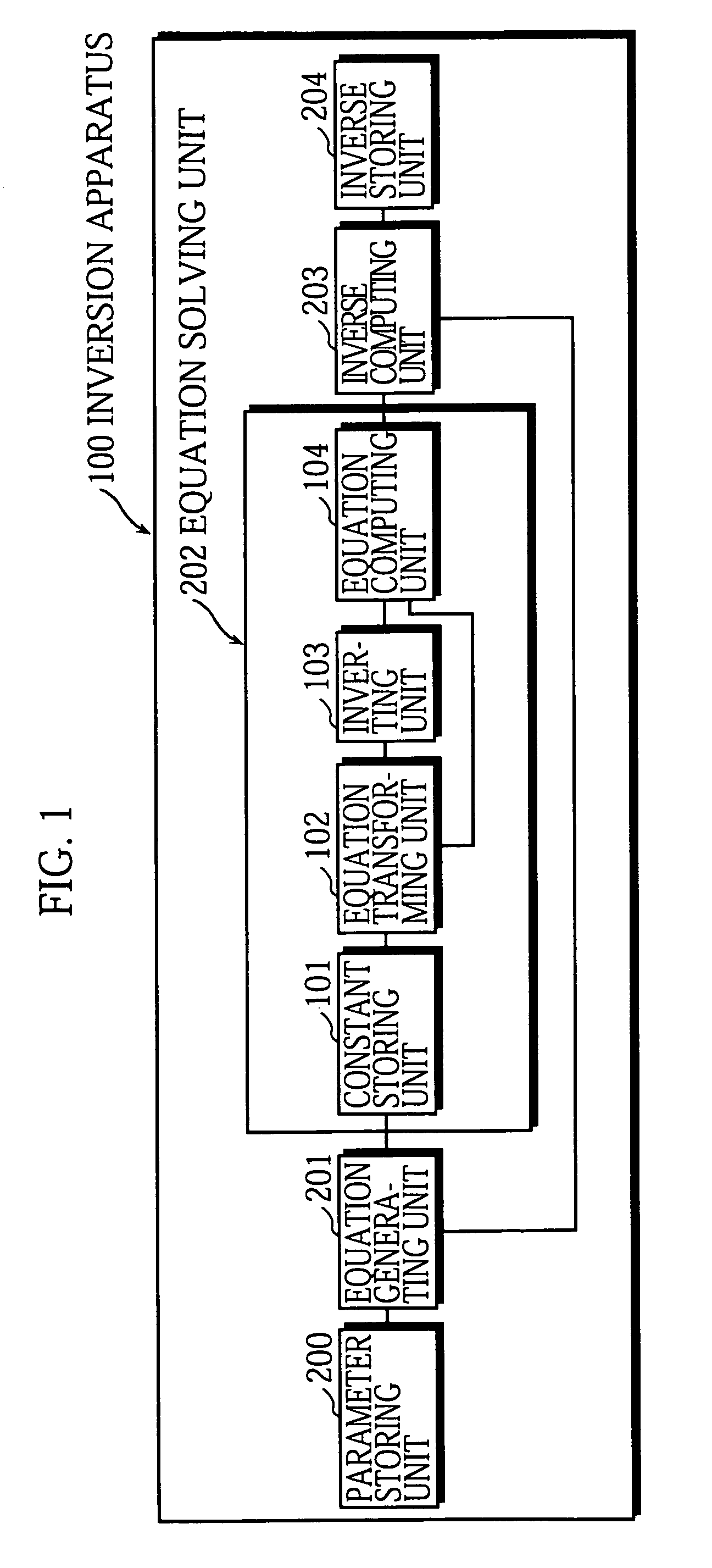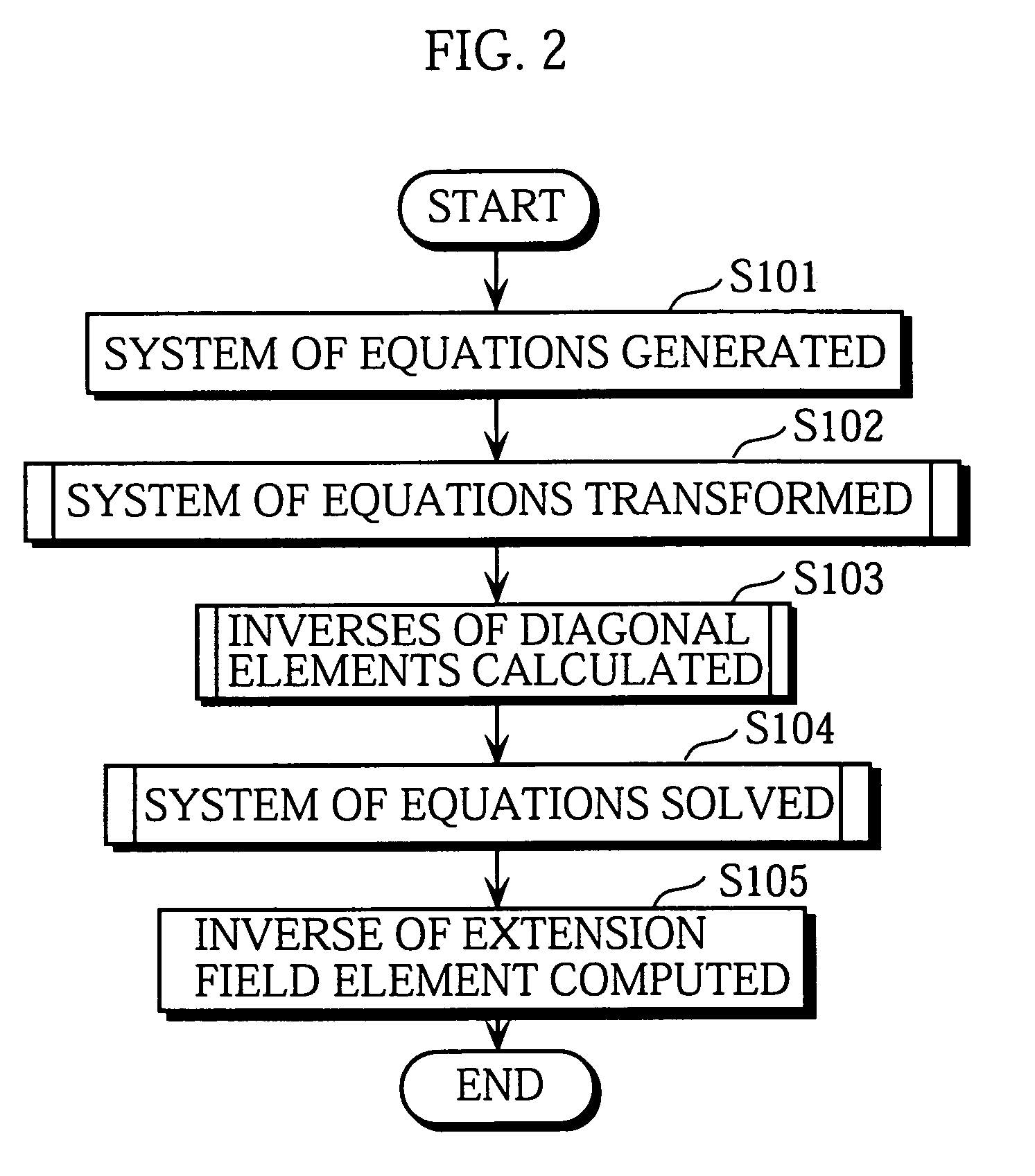Apparatus for solving system of equations on finite field and apparatus for inverting element of extension field
a technology of equations and apparatus, applied in the field of computation techniques, can solve problems such as computational complexity of (nj+1)(nj+1)mul+1inv, and the computational complexity of extended gcd is considerable, so as to reduce computational complexity and computational complexity. the effect of computational complexity
- Summary
- Abstract
- Description
- Claims
- Application Information
AI Technical Summary
Benefits of technology
Problems solved by technology
Method used
Image
Examples
embodiment
1. Embodiment
[0150]The following is a description of an inversion apparatus 100 according to an embodiment of the present invention.
1.1. Construction of the Inversion Apparatus 100
[0151]The inversion apparatus 100 computes the inverse I of an element x on GF(q) (q=pn, p a prime, n a positive integer) which is an extension field of a predetermined finite field GF(p). In this embodiment, a generator polynomial of the extension field GF(q) is gn−β whose root is α, and the element x is such that x=x0+x1α+ . . . +xn−1αn−1, where α is an element of GF(q) and β, x0, x1, . . . xn−1 are elements of GF(p).
[0152]As shown in FIG. 1, the inversion apparatus 100 is roughly made up of a parameter storing unit 200, an equation generating unit 201, an equation salving unit 202, an inverse computing unit 203, and an inverse storing unit 204.
[0153]Specifically, the inversion apparatus 100 is implemented by a computer system equipped with a microprocessor, a ROM, a RAM, a hard disk, and the like. Throu...
concrete example
[0302]An example of the operation of the equation transforming unit 102a is shown below.
[0303]As with the prior art 3, a prime p=31, a generator polynomial f(g)=g5−2, and an element x=5α4+29α3+6α219α17 of GF(q) are given. A system of equations to be solved is the same as that in the prior art 3, as shown in FIG. 8(a).
[0304]When j=1, the equation transforming unit 102a calculates
s1=a11×a21=17×19=13 mod 31
s2=s×a31=13×6=16 mod 31
h5=s2×a41=16×29=30 mod 31
h4=s2×a51=16×5=18 mod 31
s5=a41×a51=29×5=21 mod 31
h3=s1×s5=13×21=25 mod 31
s4=a31×s5=6×21=2 mod 31
h2=a11×s4=17×2=3 mod 31
h1=a21×s4=19×2=7 mod 31[0305]and then calculates
w2=h1×a12=7×10=8 mod 31
w3=h1×a13=7×27=3 mod 31
w4=h1×a14=7×12=22 mod 31
w5=h1×a15=7×7=18 mod 31
e=h1×b1=7×1=7 mod 31
[0306]When i=2 (j=1), the equation transforming unit 102a calculates
a21=0
a22=h2×a22−w2=3×17−8=12 mod 31
a23=h2×a23−w3=3×10−3=27 mod 31
a24=h2×a24−w4=3×27−22=28 mod 31
a25=h2×a25−w5=3×12−18=18 mod 31
b2=h2×b2−e=3×0−7=24 mod 31
[0307]According to this method, only one ...
PUM
 Login to View More
Login to View More Abstract
Description
Claims
Application Information
 Login to View More
Login to View More - R&D
- Intellectual Property
- Life Sciences
- Materials
- Tech Scout
- Unparalleled Data Quality
- Higher Quality Content
- 60% Fewer Hallucinations
Browse by: Latest US Patents, China's latest patents, Technical Efficacy Thesaurus, Application Domain, Technology Topic, Popular Technical Reports.
© 2025 PatSnap. All rights reserved.Legal|Privacy policy|Modern Slavery Act Transparency Statement|Sitemap|About US| Contact US: help@patsnap.com



